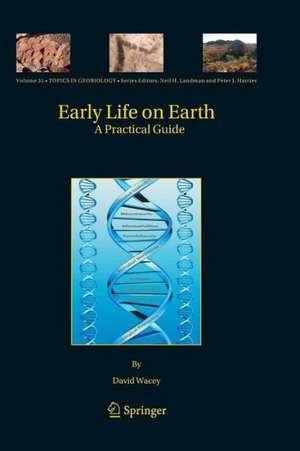Early Life on Earth: A Practical Guide: Topics in Geobiology, cartea 31
Autor David Waceyen Limba Engleză Paperback – 6 noi 2014
The first half of this practical guide equips the reader with the background knowledge to successfully evaluate new potentially biological finds from the Archean rock record. Successive steps are covered, from locating promising samples in the field, through standard petrography and evaluation of antiquity and biogenicity criteria, to the latest state of the art geochemical techniques. The second half of the guide uniquely brings together all the materials that have been claimed to comprise the earliest fossil record into an easily accessible, fully illustrated format.
This will be a handbook that every Archean geologist, palaeobiologist and astrobiologist will wish to have in their backpack or on their lab-bench.
| Toate formatele și edițiile | Preț | Express |
|---|---|---|
| Paperback (1) | 640.06 lei 6-8 săpt. | |
| SPRINGER NETHERLANDS – 6 noi 2014 | 640.06 lei 6-8 săpt. | |
| Hardback (1) | 647.40 lei 6-8 săpt. | |
| SPRINGER NETHERLANDS – 29 ian 2009 | 647.40 lei 6-8 săpt. |
Din seria Topics in Geobiology
- 18%
 Preț: 1858.10 lei
Preț: 1858.10 lei - 20%
 Preț: 822.08 lei
Preț: 822.08 lei - 15%
 Preț: 672.43 lei
Preț: 672.43 lei - 18%
 Preț: 1236.82 lei
Preț: 1236.82 lei - 15%
 Preț: 647.59 lei
Preț: 647.59 lei - 24%
 Preț: 885.02 lei
Preț: 885.02 lei - 18%
 Preț: 951.59 lei
Preț: 951.59 lei - 18%
 Preț: 964.23 lei
Preț: 964.23 lei - 18%
 Preț: 1117.69 lei
Preț: 1117.69 lei - 15%
 Preț: 633.31 lei
Preț: 633.31 lei - 18%
 Preț: 966.27 lei
Preț: 966.27 lei - 18%
 Preț: 952.54 lei
Preț: 952.54 lei - 18%
 Preț: 949.85 lei
Preț: 949.85 lei - 18%
 Preț: 1013.50 lei
Preț: 1013.50 lei - 24%
 Preț: 821.17 lei
Preț: 821.17 lei - 18%
 Preț: 952.40 lei
Preț: 952.40 lei - 18%
 Preț: 961.23 lei
Preț: 961.23 lei - 18%
 Preț: 952.26 lei
Preț: 952.26 lei - 18%
 Preț: 960.42 lei
Preț: 960.42 lei - 18%
 Preț: 1843.11 lei
Preț: 1843.11 lei - 18%
 Preț: 954.31 lei
Preț: 954.31 lei - 18%
 Preț: 1256.41 lei
Preț: 1256.41 lei - 18%
 Preț: 959.50 lei
Preț: 959.50 lei - 15%
 Preț: 673.60 lei
Preț: 673.60 lei - 18%
 Preț: 954.14 lei
Preț: 954.14 lei - 18%
 Preț: 959.36 lei
Preț: 959.36 lei
Preț: 640.06 lei
Preț vechi: 753.01 lei
-15% Nou
Puncte Express: 960
Preț estimativ în valută:
122.47€ • 127.87$ • 101.36£
122.47€ • 127.87$ • 101.36£
Carte tipărită la comandă
Livrare economică 05-19 aprilie
Preluare comenzi: 021 569.72.76
Specificații
ISBN-13: 9789400789333
ISBN-10: 9400789335
Pagini: 288
Ilustrații: X, 274 p.
Dimensiuni: 155 x 235 x 15 mm
Greutate: 0.41 kg
Ediția:2009
Editura: SPRINGER NETHERLANDS
Colecția Springer
Seria Topics in Geobiology
Locul publicării:Dordrecht, Netherlands
ISBN-10: 9400789335
Pagini: 288
Ilustrații: X, 274 p.
Dimensiuni: 155 x 235 x 15 mm
Greutate: 0.41 kg
Ediția:2009
Editura: SPRINGER NETHERLANDS
Colecția Springer
Seria Topics in Geobiology
Locul publicării:Dordrecht, Netherlands
Public țintă
ResearchCuprins
Investigating Life in Early Archean Rocks.- Setting the Scene: Milestones in the Search for Early Life on Earth.- What Can We Expect to Find in the Earliest Rock Record?.- The Difficulties of Decoding Early Life.- Establishing the Criteria for Early Life on Earth.- Fulfilling the Criteria for Early Life on Earth.- Techniques for Investigating Early Life on Earth.- An Atlas of Claims for Early Archean Life.- > 3,700 Ma Isua Supracrustal Belt and Akilia Island, S.W. Greenland.- ˜3,490 Ma Dresser Formation, East Pilbara, Western Australia.- ~3,470 Ma Mount Ada Basalt, East Pilbara, Western Australia.- ~3,460 Ma Apex Basalt, East Pilbara, Western Australia.- ~3,450 Ma, Hoogenoeg Formation, Barberton, South Africa.- ~3,450 Ma, Panorama Formation, East Pilbara, Western Australia.- ˜3,426–3,350 Ma, Strelley Pool Formation, East Pilbara, Western Australia.- ?3,416–3,334 Ma, Kromberg Formation, Barberton, South Africa.- ~3,350 Ma, Euro Basalt, East Pilbara, Western Australia.- ~3,250 Ma, Fig Tree Group, Barberton, South Africa.- ~3,240 Ma, Kangaroo Caves Formation, East Pilbara, Western Australia.- ~3,200 Ma, Moodies Group, Barberton, South Africa.- ~3,200 Ma, Dixon Island Formation, Cleaverville Greenstone Belt, West Pilbara, Western Australia.- ~3,000 Ma, Cleaverville Formation, Cleaverville Greenstone Belt, West Pilbara, Western Australia.- ~3,000 Ma, Farrel Quartzite, East Pilbara, Western Australia.- THE IMPOSTERS: Younger Biological Contaminants and Non-Biological Artefacts.- Erratum to.
Recenzii
From the reviews:
"Suitable for graduate students and early career researchers, this book provides a useful introduction to the current understanding of life on the early Earth. The excellent images and use of bullet points and tables to encapsulate key information make this book highly readable … providing suggestions for additional reading for those who want (or need) to know more. The text is clear and well-written … . This book is thought-provoking … ." (Alison J. Wright, The Astrobiology Society of Britain, September, 2009)
“Wacey … has chosen a daunting task: to review everything more than three billion years old that anyone has interpreted as a body, trace, or chemical remnant of life on Earth. … At approximately 100 pages, this overview is quite succinct, yet well illustrated and comprehensively referenced. … Pound for pound, this may be the best available summary of evidence of Earth’s earliest life … a good introduction for nonspecialists. Summing Up: Highly recommended. Upper-division undergraduate through professional collections.” (B. M. Simonson, Choice, Vol. 47 (3), November, 2009)
“Gives the reader a general overview of early-life studies … . The topics are presented in such a way that even a non-scientist would be able to grasp most of the basic concepts. … The topics covered are well-organized and clearly explained, and each section is followed by extensive lists of references for further reading. I would certainly use this book as the basis of an introductory course curriculum at the upper undergraduate or graduate level.” (Dina M. Bower, Geologos, Vol. 16 (3), September, 2010)
"Suitable for graduate students and early career researchers, this book provides a useful introduction to the current understanding of life on the early Earth. The excellent images and use of bullet points and tables to encapsulate key information make this book highly readable … providing suggestions for additional reading for those who want (or need) to know more. The text is clear and well-written … . This book is thought-provoking … ." (Alison J. Wright, The Astrobiology Society of Britain, September, 2009)
“Wacey … has chosen a daunting task: to review everything more than three billion years old that anyone has interpreted as a body, trace, or chemical remnant of life on Earth. … At approximately 100 pages, this overview is quite succinct, yet well illustrated and comprehensively referenced. … Pound for pound, this may be the best available summary of evidence of Earth’s earliest life … a good introduction for nonspecialists. Summing Up: Highly recommended. Upper-division undergraduate through professional collections.” (B. M. Simonson, Choice, Vol. 47 (3), November, 2009)
“Gives the reader a general overview of early-life studies … . The topics are presented in such a way that even a non-scientist would be able to grasp most of the basic concepts. … The topics covered are well-organized and clearly explained, and each section is followed by extensive lists of references for further reading. I would certainly use this book as the basis of an introductory course curriculum at the upper undergraduate or graduate level.” (Dina M. Bower, Geologos, Vol. 16 (3), September, 2010)
Notă biografică
David Wacey is a University Research Fellow at the University of Western Australia in Perth. He graduated with honours from Oxford University in 1998 and then undertook a D.Phil. investigating the geochemistry and microbiology of modern and ancient dolomite formation. It was during this time that he became interested in primitive microbes and how the earliest life on Earth may have arisen and evolved. On completion of his D. Phil he decided to concentrate his research on the earliest rocks found on Earth. After 12 years at Oxford he relocated to Western Australia where he now works on a number of problems relating to the recognition and understanding of the earliest signs of life of Earth. More information can be found here: http://cmca.uwa.edu.au/contact_directory
Caracteristici
The main aim is to draw attention to the remarkable number of highly interesting candidate structures in the quest to decode the earliest evidence for life on Earth Will cover the Victorian Eozoon controversy, the ongoing stromatolite debate, and the recent Apex microfossil debate Features a large number of geochemical high resolution illustrations including thin section photomicrographs, field outcrop photographs and scanning electron microscope images including detailed descriptions and balanced interpretations of the structures so that the reader can compare and contrast Will act as a reference guide and practical pictorial textbook for students and researchers into early life










